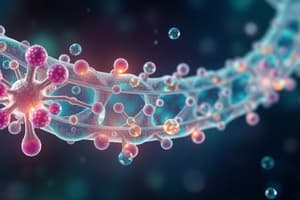Podcast
Questions and Answers
What is a characteristic of homogenous immunoassays?
What is a characteristic of homogenous immunoassays?
- They can be either competitive or non-competitive. (correct)
- They are only applicable for large proteins.
- They require multiple washing steps.
- They necessitate separation of components before analysis.
What is the primary purpose of an immunoassay?
What is the primary purpose of an immunoassay?
- To exploit the properties of antibody-antigen complexes. (correct)
- To detect and quantify antibody concentrations.
- To separate proteins from each other.
- To measure the volume of a solution.
Which statement best describes heterogenous immunoassays?
Which statement best describes heterogenous immunoassays?
- They can be performed with no separation steps.
- They require multiple steps of washing or blocking. (correct)
- They involve a single-step filtration process.
- They are faster than homogenous assays.
What does the term 'conjugation' in immunoassays refer to?
What does the term 'conjugation' in immunoassays refer to?
Which of the following is NOT a consideration for immunoassay design?
Which of the following is NOT a consideration for immunoassay design?
What type of standard curve is generated when plotting the concentration of bound label against analyte concentration?
What type of standard curve is generated when plotting the concentration of bound label against analyte concentration?
In a homogeneous competitive immunoassay, what do both the labeled and unlabeled analytes compete for?
In a homogeneous competitive immunoassay, what do both the labeled and unlabeled analytes compete for?
Which of the following is NOT a component that can be conjugated to antibodies or antigens for detection?
Which of the following is NOT a component that can be conjugated to antibodies or antigens for detection?
Which technique involves linking antibodies or antigens to another molecule for detection and quantitation?
Which technique involves linking antibodies or antigens to another molecule for detection and quantitation?
What is the purpose of washing in the competitive immunoassay process?
What is the purpose of washing in the competitive immunoassay process?
What is a characteristic of non-competitive immunoassays?
What is a characteristic of non-competitive immunoassays?
How does the signal in a non-competitive immunoassay correlate with the antigen concentration?
How does the signal in a non-competitive immunoassay correlate with the antigen concentration?
Which of the following statements about competitive immunoassays is true?
Which of the following statements about competitive immunoassays is true?
What is an advantage of non-competitive immunoassays?
What is an advantage of non-competitive immunoassays?
What is a limitation of non-competitive immunoassays?
What is a limitation of non-competitive immunoassays?
Which solid phases can be used in heterogeneous assays?
Which solid phases can be used in heterogeneous assays?
What is a key factor in the effectiveness of competitive immunoassays?
What is a key factor in the effectiveness of competitive immunoassays?
What potential issue is associated with using micro-titre plates in assays?
What potential issue is associated with using micro-titre plates in assays?
Flashcards
What are Immunoassays?
What are Immunoassays?
Immunoassays are laboratory techniques that utilize the specific binding between antibodies (Ab) and antigens (Ag) to detect and quantify analytes.
Homogenous Assays
Homogenous Assays
Homogenous assays do not require a physical separation step before analysis, meaning all reagents are mixed together, and no washing or blocking steps are needed.
Heterogenous Assays
Heterogenous Assays
Heterogenous assays require a separation step before analysis, involving steps like washing and blocking to separate bound and unbound components.
Non-competitive Assays
Non-competitive Assays
Signup and view all the flashcards
Competitive Assays
Competitive Assays
Signup and view all the flashcards
Competitive Immunoassay
Competitive Immunoassay
Signup and view all the flashcards
Non-competitive Immunoassay
Non-competitive Immunoassay
Signup and view all the flashcards
Heterogenous Competitive Immunoassay
Heterogenous Competitive Immunoassay
Signup and view all the flashcards
Advantages and Disadvantages of Non-competitive Immunoassays
Advantages and Disadvantages of Non-competitive Immunoassays
Signup and view all the flashcards
Advantages of Heterogenous Competitive Immunoassay
Advantages of Heterogenous Competitive Immunoassay
Signup and view all the flashcards
Signal in Non-competitive Immunoassay
Signal in Non-competitive Immunoassay
Signup and view all the flashcards
Sensitivity of Competitive Immunoassay
Sensitivity of Competitive Immunoassay
Signup and view all the flashcards
Conjugation
Conjugation
Signup and view all the flashcards
Homogeneous Immunoassay
Homogeneous Immunoassay
Signup and view all the flashcards
Heterogeneous immunoassay
Heterogeneous immunoassay
Signup and view all the flashcards
Study Notes
Introduction to Immunoassays
- Immunoassays use immunochemical methods to exploit the properties of antibody-antigen (Ab-Ag) complexes
- Antibodies (Abs) are used as reagents to detect and quantify antigens (Ags)
- A wide range of compounds, from small molecules to large proteins, can be measured using immunoassays
Learning Objectives
- Describe the characteristics of homogenous and heterogeneous assays
- Outline the principles of non-competitive and competitive immunoassays
- Understand the meaning of conjugation
- List components of immunoassays that can be conjugated to antibodies and antigens
Immunoassay Design
- Careful selection of antibodies (Abs) with appropriate binding strength and specificity is crucial
- Abs should exhibit high affinity and high specificity for the target antigen
- Choosing the correct label and detection method is essential for measuring Ab:Ag binding
- Labelled Abs and Ag complexes are combined through covalent attachments (conjugation)
- Enzyme-substrate interactions generate signals that are detected
- Signal detection is a critical step in immunoassay design
Homogenous vs. Heterogenous Assays
- Homogenous immunoassays: Do not require separation steps before analysis; reagents are added simultaneously; can be competitive or non-competitive
- Heterogenous immunoassays: Require separation steps (e.g., filtration, washing, blocking) before analysis; typically multiple steps; can be competitive or non-competitive; are the most common type of immunoassay
Heterogenous Assay Characteristics
- Can be either competitive or non-competitive
- Immuno-reagents are attached to a solid phase (e.g., agarose, polystyrene beads, microtiter plates) via covalent or non-covalent (adsorption) methods
- Factors to consider during heterogeneous assay design include:
- Immunoreaction or Ab-Ag binding should not affect signal generation
- The enzyme label should retain its activity after the immunoreaction
- Non-specific adsorption of components can affect the results
- Solid phase material and edge effects can impact the results
Non-competitive Immunoassays
- An excess of unlabelled antibody captures the analyte from the sample
- A labelled secondary antibody binds to the captured analyte forming a 'sandwich' complex
- The signal generated, measured spectrophotometrically, is directly proportional to the analyte concentration
- Non-competitive techniques are generally more sensitive and reproducible than competitive assays
Non-competitive Immunoassays (Sandwich ELISA)
- Unlabeled capture antibody is immobilzed on a solid surface
- Sample (analyte) is added
- Capture antibody binds to its target antigen within the sample
- Detection antibody (linked to an enzyme) is added, binding to the second region of the antigen to form a 'sandwich'
- An enzyme substrate is added to generate a signal (colorimetric changes are commonly measured spectrophotometrically)
- Wash steps are done to remove unbound components
Non-competitive Immunoassays: Advantages and Limitations
- Advantages: Excellent detection in complex samples such as plasma and serum; high specificity and sensitivity
- Limitations: Requires carefully matched antibody pairs; difficult to test very small antigens
Heterogenous Competitive Immunoassays
- Labeled and unlabeled analytes (antigens) compete for a limited number of binding sites on the antibody
- Less label measured in the assay means more unlabeled competitor antigen is present (inverse relationship)
- Concentration of bound label is plotted against the analyte concentration resulting in an inverse standard curve
Homogenous Competitive Immunoassays
- Both the labeled antigen and the unlabeled antigen (from the sample) compete for a limited amount of antibody
- Fewer labeled complexes found when analyte concentrations are higher
Competitive Immunoassays
- Capture antibody is immobilized on a solid phase
- Analyte (antigen) and enzyme-labelled analyte compete for limited antibody binding sites
- Washing removes unbound material
- Enzyme substrate is added to produce a signal
Activity - Comparison of ELISA Procedures
- Sandwich ELISA: Antibody-coated well → analyte addition → enzyme-conjugated antibody addition
- Competitive ELISA: Antibody-coated well → analyte and labelled analyte addition → enzyme-conjugated antibody addition (signals inversely correlate with analyte concentration)
Conjugation & Detection Techniques
- Conjugation is linking either antigen or antibody to another molecule for detection or quantitation
- Antigens or antibodies can be conjugated to various molecules including:
- Enzymes (e.g., alkaline phosphatase, horseradish peroxidase)
- Fluorescent labels (e.g., fluorescein isothiocyanate)
- Biotin/avidin
- Beads (e.g., polystyrene, magnetic)
- Isotopic labels (e.g., 3H, 125I, 14C)
Studying That Suits You
Use AI to generate personalized quizzes and flashcards to suit your learning preferences.



